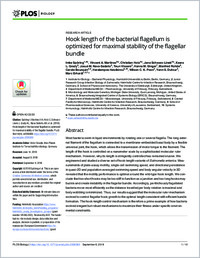Hook length of the bacterial flagellum is optimized for maximal stability of the flagellar bundle
- Spöring, Imke Institute for Biology and Bacterial Physiology, Humboldt-Universität zu Berlin, Berlin, Germany - Junior Research Group Infection Biology of Salmonella, Helmholtz Centre for Infection Research, Braunschweig, Germany
- Martinez, Vincent A. School of Physics and Astronomy, The University of Edinburgh, Edinburgh, UK
- Hotz, Christian Department of Medicine, Pharmacology, University of Fribourg, Switzerland,
- Schwarz-Linek, Jana School of Physics and Astronomy, The University of Edinburgh, Edinburgh, UK
- Grady, Keara L. Microbiology and Molecular Genetics, Michigan State University, East Lansing, USA
- Nava-Sedeño, Josué M. Braunschweig Integrated Centre of Systems Biology (BRICS), Braunschweig, Germany
- Vissers, Teun School of Physics and Astronomy, The University of Edinburgh, Edinburgh, UK
- Singer, Hanna M. Department of Medicine, Microbiologie, University of Fribourg, Switzerland
- Rohde, Manfred Central Facility for Microscopy, Helmholtz Centre for Infection Research, Braunschweig, Germany
- Bourquin, Carole Department of Medicine, Pharmacology, University of Fribourg, Switzerland, - School of Pharmaceutical Sciences, University of Geneva, Switzerland
- Hatzikirou, Haralampos Braunschweig Integrated Centre of Systems Biology (BRICS), Braunschweig, Germany - Systems Immunology, Helmholtz Centre for Infection Research, Braunschweig, Germany
- Poon, Wilson C. K. School of Physics and Astronomy, The University of Edinburgh, Edinburgh, UK
- Dufour, Yann S. Microbiology and Molecular Genetics, Michigan State University, East Lansing, USA
- Erhardt, Marc Institute for Biology and Bacterial Physiology, Humboldt-Universität zu Berlin, Berlin, Germany - Junior Research Group Infection Biology of Salmonella, Helmholtz Centre for Infection Research, Braunschweig, Germany - Department of Medicine, Microbiologie, University of Fribourg, Switzerland
-
06.09.2018
Published in:
- PLOS Biology. - 2018, vol. 16, no. 9, p. e2006989
English
Most bacteria swim in liquid environments by rotating one or several flagella. The long external filament of the flagellum is connected to a membrane-embedded basal body by a flexible universal joint, the hook, which allows the transmission of motor torque to the filament. The length of the hook is controlled on a nanometer scale by a sophisticated molecular ruler mechanism. However, why its length is stringently controlled has remained elusive. We engineered and studied a diverse set of hook- length variants of Salmonella enterica. Measurements of plate-assay motility, single- cell swimming speed, and directional persistence in quasi-2D and population- averaged swimming speed and body angular velocity in 3D revealed that the motility performance is optimal around the wild-type hook length. We conclude that too-short hooks may be too stiff to function as a junction and too-long hooks may buckle and create instability in the flagellar bundle. Accordingly, peritrichously flagellated bacteria move most efficiently as the distance travelled per body rotation is maximal and body wobbling is minimized. Thus, our results suggest that the molecular ruler mechanism evolved to control flagellar hook growth to the optimal length consistent with efficient bundle formation. The hook-length control mechanism is therefore a prime example of how bacteria evolved elegant but robust mechanisms to maximize their fitness under specific environmental constraints.
- Faculty
- Faculté des sciences et de médecine
- Department
- Département de Médecine
- Language
-
- English
- Classification
- Biological sciences
- License
-
License undefined
- Identifiers
-
- RERO DOC 323436
- DOI 10.1371/journal.pbio.2006989
- Persistent URL
- https://folia.unifr.ch/unifr/documents/307312
Statistics
Document views: 159
File downloads:
- pdf: 225
